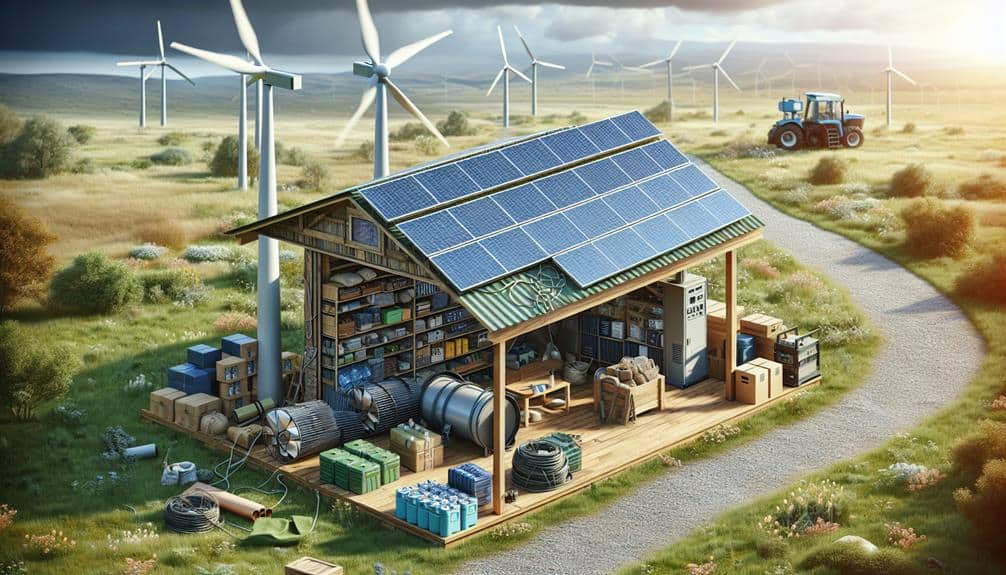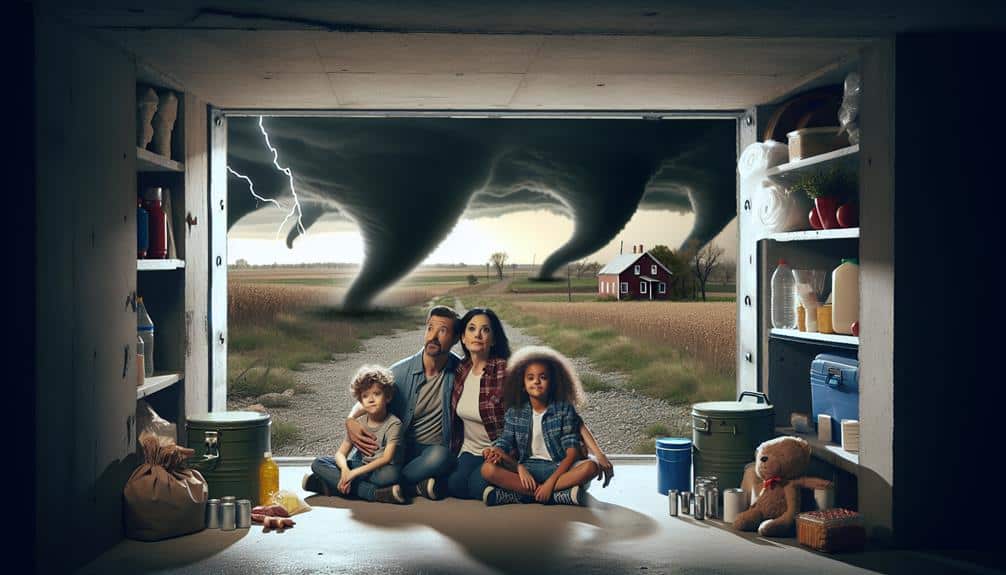We can rely on several locations with backup power for storm shelters. Community centers and public schools are equipped with generators and designed to accommodate large groups. Hospitals are essential due to their strong infrastructure and reliable power systems. Fire stations and emergency shelters guarantee continued power with backup generators and, sometimes, renewable sources like solar panels. Government buildings also provide secure shelter with robust backup power and serve as important hubs for emergency responses. Let's explore further to see how these spots keep us safe during storms.
Key Points
- Community centers have backup generators and durable materials, making them reliable storm shelters.
- Public schools are centrally located with strong infrastructure and reliable backup power systems.
- Hospitals offer storm shelter with strong backup power systems and medical equipment for emergencies.
- Fire stations incorporate backup generators and renewable power sources like solar panels and wind turbines.
Community Centers
Community centers often serve as reliable storm shelters due to their robust infrastructure and backup power systems. When severe weather strikes, we need safe spaces that guarantee our continued safety and comfort. Community centers are designed with durable materials and are built to withstand extreme conditions, making them ideal sanctuaries during storms.
One of the key advantages of community centers is their diverse power options. These facilities are equipped with backup generators to guarantee that essential services remain operational even if the main power grid fails. This means we can rely on having lighting, heating, cooling, and essential medical equipment available when we need it most.
The presence of backup generators is particularly critical. These generators kick in automatically during power outages, providing a seamless shift and uninterrupted power supply. This reliability allows us to focus on staying safe and calm, knowing that the facility's systems are functioning as intended.
In addition to backup power, community centers often have large, open spaces that can accommodate many people comfortably. This secures that, in times of crisis, we've a safe place to gather and find refuge. Community centers truly offer a haven with their sturdy construction and dependable power solutions.
Public Schools
Public schools also serve as vital storm shelters, offering strong infrastructure and dependable backup power systems to safeguard community safety during severe weather events. These facilities are strategically designed to withstand harsh conditions, guaranteeing that our communities have a safe haven when nature is at its worst.
Shelter accessibility is a key advantage of using public schools as storm shelters. Many schools are centrally located within neighborhoods, making it easy for residents to reach them quickly. This accessibility is important when time is of the essence, and every second counts.
In terms of shelter capacity, public schools often have the space to accommodate large groups of people. Gymnasiums, cafeterias, and auditoriums can be repurposed to house individuals and families seeking refuge. This ability to host substantial numbers is essential during widespread emergencies, where smaller shelters might quickly become overwhelmed.
Furthermore, public schools are equipped with reliable backup power systems. These systems ensure that critical services remain operational, including lighting, heating or cooling, and communication networks. By maintaining these essential functions, schools provide a stable and secure environment for all who seek shelter, reinforcing our collective resilience in the face of adversity.
Hospitals
Hospitals are crucial storm shelters because they house essential medical equipment that must remain operational.
We must guarantee these facilities have strong backup power systems to support their emergency preparedness plans.
Essential Medical Equipment
Ensuring that essential medical equipment remains operational during a storm is crucial for patient safety and care continuity. In hospitals, critical devices like ventilators, infusion pumps, and dialysis machines are non-negotiable for saving lives. That's why we must guarantee these facilities have robust backup power systems.
When the main grid fails, portable generators become the unsung heroes. These units kick in almost immediately, providing the necessary electricity to keep essential medical supplies and equipment functioning without interruption. We can't afford to have lifesaving treatments halted due to power outages, especially during severe weather events when hospital admissions often surge.
Our reliance on dependable power sources doesn't end there. Modern medical devices require a consistent and clean power supply to operate effectively. Even a minor fluctuation can compromise the functionality of sensitive equipment, potentially putting patients at risk. Thus, hospitals often invest in high-quality, reliable portable generators that can handle the load demand.
Emergency Preparedness Plans
Developing a thorough emergency readiness plan is necessary to ensure hospitals can effectively respond to and manage crises. We must make sure that our facilities are equipped with reliable backup power systems, similar to what we might have in home shelters. Hospitals can't afford power interruptions, especially in critical areas like ICUs and operating rooms.
Let's prioritize portable generators as a key component of our emergency power options. These generators are essential for maintaining electrical supply during outages. They can be strategically placed throughout the hospital, guaranteeing that essential medical equipment continues to function seamlessly.
Additionally, having a robust stock of emergency kits is a non-negotiable aspect of preparedness. These kits should include medical supplies, batteries, and other necessities that can support both patients and staff during prolonged crises.
We also need to conduct regular drills and training sessions to make certain every staff member knows their role in an emergency. This proactive approach ensures we're not just prepared for the expected but also the unforeseen.
Fire Stations
Let's focus on fire stations, which are important for their reliable power sources during storms.
They've got strong emergency preparedness plans and act as significant community safety measures.
Ensuring these stations have backup power is necessary for maintaining public safety.
Reliable Power Sources
Fire stations serve as dependable power sources for storm shelters due to their robust backup generators and infrastructure. We depend on these facilities to ensure that essential services remain operational during emergencies.
Many fire stations incorporate a combination of solar panels and traditional generators, creating a hybrid system that maintains continuous power. Solar panels capture and store energy, significantly reducing dependence on fuel and making these locations more resilient against prolonged power outages.
In addition to solar panels and generators, fire stations often utilize battery backups to store excess energy. These battery systems are vital for maintaining power during the night or in overcast conditions when solar energy is less abundant.
Furthermore, some fire stations are starting to incorporate wind turbines into their energy mix. These turbines harness wind energy, providing an additional renewable power source that complements solar panels and battery backups.
Emergency Preparedness Plans
With reliable power sources in place, we can focus on creating thorough emergency preparedness plans at fire stations to guarantee public safety during storms. Our first priority is ensuring that our fire stations are equipped with all necessary emergency supplies. This includes medical kits, food, water, and other essentials that will support both our firefighters and the community members they assist.
Next, we need to emphasize the importance of home preparations. Families should have their own emergency supplies ready and accessible. It's critical that everyone establishes clear communication plans. Knowing how to reach each other and which fire station to head to in case of separation is essential.
We also need to develop robust family reunification plans. Fire stations should have designated areas where families can reunite safely. Ensuring that these areas are well-marked and informative will help reduce chaos and anxiety during emergencies.
Community Safety Measures
Maintaining community safety during storms requires our fire stations to implement strategic measures that protect and inform the public. Our fire stations aren't only equipped with backup power but also serve as essential hubs for emergency coordination and information dissemination. When the power goes out, we can rely on these stations to stay operational and provide crucial support.
One key measure is integrating public transportation systems with fire station operations. During a storm, disruptions to transportation can impede evacuation and rescue efforts. By coordinating with public transportation services, our fire stations ensure timely and efficient movement of people to safer locations.
Additionally, fire stations play an important role in fostering neighborhood watch programs. By working closely with local volunteers, they enhance community vigilance and guarantee rapid reporting of emergencies. This cooperation is necessary for real-time updates and swift responses, notably reducing response times and increasing overall safety.
In essence, our fire stations' preparedness and their collaboration with public transportation and neighborhood watch groups form the backbone of our community safety measures. Together, we can weather any storm with resilience and assurance, knowing that our emergency services are robust and ready.
Emergency Shelters

Emergency shelters equipped with backup power are necessary for guaranteeing safety and maintaining operations during a storm. When we're facing severe weather, reliable power at emergency shelters can mean the difference between chaos and order. These shelters not only provide a safe haven but also guarantee that critical systems remain operational, which is essential for everyone's well-being.
Home safety is our top priority when we consider emergency shelters. Backup power guarantees that essential services like lighting, heating, and medical equipment continue to function. In the midst of a storm, the last thing we want is to be left in the dark or without heat. This reliability helps us feel secure and allows us to focus on what really matters—keeping our loved ones safe.
Additionally, having emergency supplies readily available in these power-equipped shelters is important. From food and water to medical kits, these supplies can sustain us during power outages and other disruptions. Knowing that these shelters are prepared with both backup power and emergency supplies gives us the freedom to act swiftly and confidently when a storm hits.
Government Buildings
Government buildings play a pivotal role in providing secure storm shelters equipped with backup power for communities. These buildings are designed to guarantee that everyone has a safe place to go during severe weather events. Plus, they often house critical local services and resources that are essential in emergencies.
- Reliability: Government buildings are among the first to be equipped with dependable backup power systems, ensuring continuous operation during power outages.
- Library Resources: Many government buildings double as public libraries, offering access to library resources such as internet, information, and communication tools during a storm.
- Accessibility: These shelters are strategically located within communities, making them easily reachable to a large population.
- Capacity: They're designed to accommodate a significant number of people, providing ample space for families and individuals seeking refuge.
Frequently Asked Questions
How Do I Find the Nearest Storm Shelter With Backup Power?
We should check local emergency preparedness websites for community resources. They often list storm shelters with backup power. For alternative shelter options, contact local government assistance programs. Staying informed guarantees we have the freedom to choose.
Are There Any Mobile Apps for Locating Storm Shelters With Backup Power?
Imagine the freedom of knowing exactly where to go during a storm! There are mobile apps with features like GPS tracking, emergency notifications, and user reviews that help us locate storm shelters with backup power.
Can Private Residences Offer Storm Shelters With Backup Power?
Yes, private residences can offer storm shelters with backup power. Residential options often include generators or solar panels, enhancing safety. Leveraging community resources can further fortify our preparedness, ensuring we're well-equipped during emergencies.
What Types of Backup Power Systems Are Used in Storm Shelters?
Picture a fortress against nature's fury. We often see storm shelters equipped with solar panels, generators, battery storage, and wind turbines. These systems guarantee we stay powered and free, even during the wildest storms.
Are There Any Costs Associated With Using Storm Shelters With Backup Power?
We need to take into account cost considerations and accessibility when using storm shelters with backup power. Maintenance requirements can add to expenses, but funding opportunities might offset costs. Ensuring everyone's safety and freedom during storms is our priority.


